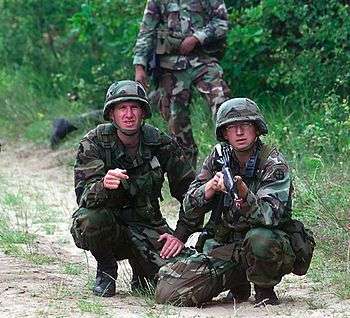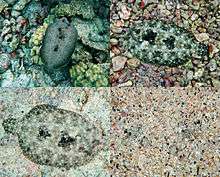U.S. Woodland

The Woodland Pattern was the default camouflage pattern issued to United States soldiers, Marines, airmen, and sailors from 1981, with the issue of the Battle Dress Uniform, until its replacement around 2006.[1][2][3] It is a four color, high contrast disruptive pattern with irregular markings in sand, brown, green and black.
Development and history
Woodland pattern is identical to ERDL, but is printed from an enlargement of the original.[2] The ERDL pattern was enlarged and the borders of the splotches were re-drawn to make them less regular. Part of the earlier pattern was left off the later pattern because the enlargement made them no longer fit on the width of the bolt of cloth. The pattern does not repeat horizontally across the width of the bolt, but only vertically along its length.
The effect of enlarging the pattern was to make the pattern more visible at a distance, avoiding "blobbing", where smaller areas of color seem to blend into larger blobs. This also gave the pattern a higher contrast, making it stand out more sharply at close distances and defeating the camouflage effect at closer range. Digital and Flecktarn camouflage patterns resolve this problem by using a range of blob sizes to give a similar effect whatever the distance.
These changes reflected a shift in the tactical focus of the United States military from an extremely close-range war in Vietnam to a longer-range battlespace on the fields of Europe.
Usage

U.S. Army
In the U.S. Army, the Woodland Pattern BDU was replaced by the digital Universal Camouflage Pattern Army Combat Uniform in 2004.
U.S. Navy
The U.S. Navy retains the Woodland Pattern BDU for specific units and organizations, such as the U.S. Navy SEALs, who are currently the primary U.S. users of this uniform. Sailors have otherwise transitioned to the Navy Working Uniform.
U.S. Marines
The Woodland Pattern BDU was phased out by the Marine Corps with the introduction of the digital MARPAT Marine Corps Combat Utility Uniform in 2002, although it was reintroduced for the United States Marine Corps Forces Special Operations Command in 2011[4] and is currently worn by MARSOC forces in Afghanistan. Regular Marines competing in Exercise Combined Resolve II at Grafenwoehr Training Area, Germany, in May 2014 also wore it.
U.S. Air Force
The Air Force dropped the Woodland Pattern BDU when they went to the Airman Battle Uniform in 2011 which uses a modern incarnation of the Tigerstripe pattern. The USAF's civilian auxiliary (Civil Air Patrol) retains the Woodland Pattern BDU as a utility uniform along with ABU, but will be scheduled to be phased out by ABU in 2021.[5]
Non-military
Various U.S law enforcement and SWAT teams use the woodland pattern for their personnel as well.
See also
References
- ↑ Battle Dress Uniform (Bdu)
- 1 2 "Woodland - Camopedia". camopedia.org. Retrieved 2016-11-10.
- ↑ Christine O. Hardyman, ed. (1988). "Chapter 7: Support Services". Department of the Army Historical Summary FY 1981. United States Army Center of Military History.
- ↑ http://kitup.military.com/2011/08/marsoc-adopts-woodland-crye-precision-uniform.html
- ↑ CAP Transition to ABUs
